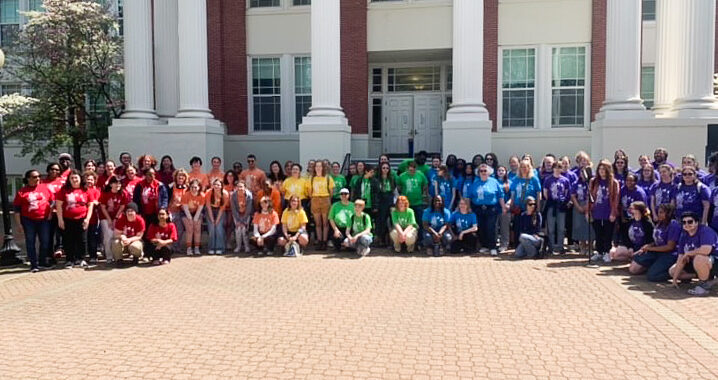Mass Email Cut Has Downside
4 min readBy MARY DAVID
University officials have recently changed the mass e-mail policy in efforts to reduce the number of e-mails going out to all faculty and students.
While some of the administration seems positive about the change, faculty have expressed concern that the policy is too restrictive. Most students have not noticed a significant difference in the number of e-mails they receive.
As of Nov. 17, e-mails addressed to all students must be sent to the Office of Student Activities and Community Services (OSACS) for distribution unless they are urgent. Once an optional method for faculty and students to send all student e-mails, this is now supposed to be the only means for e-mailing non-vital information to all students.
Faculty e-mails that are not urgent must be distributed through The Digest, the faculty newsletter. Administration officials say the e-mail system will eventually be upgraded so that faculty can target specific groups of students instead of e-mailing everyone.
Teresa Mannix, interim director of news and public information, defined mass e-mail or broadcast e-mail as “an e-mail sent to a defined group.” She cited examples such as e-mails sent to all students, all faculty, or all administrators.
Other schools such as the University of Virginia and Old Dominion University have policies to restrict mass e-mails as well, although Mannix said the administration did not conduct official research or attempt to get faculty input when developing the policy.
Sophomore Marie Coates said the effect of the new policy has been minimal.
“I haven’t really noticed a change,” Coates said.
Under the old system, many faculty were able to send out broadcast e-mails to all faculty and students through an option in their e-mail account, according to Chip German, vice president for information resources and chief information officer.
According Rosemary Barra, interim vice president of academic affairs and faculty dean, the new system requires the vice president of the concerned department to review all official or urgent broadcast e-mails before they are sent.
If the concerned vice president considers an all-student e-mail official or urgent, their office will send the broadcast e-mail to students. If the official or urgent e-mail pertains to faculty, the concerned vice president will send it to the Office of University Relations for distribution.
Other time-sensitive or urgent notices such as snow closings or weather advisories must be sent to the Office of University Relations to be sent out in an email to all students. The office may also post them under “Campus Advisories” on the University’s Web site.
As vice president of student affairs, Bernard Chirico has been receiving more e-mails since the policy change.
“Certainly there are more contacts being made than there would be otherwise,” he said. “I get well over 100 e-mails a day.”
Still, Chirico said that the new system seems to be “a positive and a benefit” so far.
Several faculty expressed resistance to the change at the faculty senate meeting on Dec. 6.
According to the meeting’s minutes, professor of music David Long said “he did not feel that the solution to students’ not reading e-mail was to take away the ability to send e-mail.”
Melina Patterson, professor of geography, said that she is “capable of deciding for herself whether she felt an e-mail was important and didn’t mind occasionally receiving irrelevant e-mails.”
Both professors seemed to feel unfairly limited by the new policy.
The minutes stated that Long considered it “demeaning to his colleagues for them to have to ask him as chair or the administration to send a message.”
Mannix said that time-sensitive and urgent e-mails require a less extensive approval process than the other messages.
“The goal was to make sure that we are sharing information in the most efficient way possible,” Mannix said. “We thought this would be a good way to help everybody find what information they really need to know in their e-mail, because students said there were just deleting stuff. Students were getting so many e-mails [that] it was hard to find the important information.”
“We would often have students that would say ‘I didn’t know that,’ or ‘I never got anything about it,’ [referring to an official e-mail] and then when you talk to them you got the response, ‘oh well I just delete all those mass e-mails,’” Barra said.
According to Mannix, a lot of crucial messages are distributed to students via e-mail such as information about class registration and advising times, but that the “information overload” was preventing students from reading all the notifications.
Barra said in an e-mail to faculty that due to the previous e-mail system, “the medium was quickly losing its effectiveness.”
Senior Mary Haggerty confirmed Mannix and Barra’s accounts.
“I rarely read the e-mails because I got so many,” Haggerty said. “It really bothered me that they sent so many e-mails, especially the e-mails that they could so easily send to only the people they apply to.”
Senior Laura Zamperini said she thought the University used to send out “a reasonable number of e-mails to students.”
According to Mannix, the change in policy has been beneficial to students and faculty.
“I’ve noticed that there’s a lot less going out by e-mail,” Mannix said. “From our end it’s been working very efficiently.”
Some faculty are unsure if the new policy is more effective than the old system.
“I have not seen any serious effect on how communication gets out,” said linguistics professor Christina Kakava. “It has definitely put a filter, but I think all of the e-mails I was getting before I’m getting now, they only come from a different source.”
Kakava said she has received information about retirement parties and at least four announcements for the holiday schedule since the policy has been implemented.
“I hope this institution will assess whether this policy will be effective and whether it will down the policy of mass e-mails,” Kakava said.











